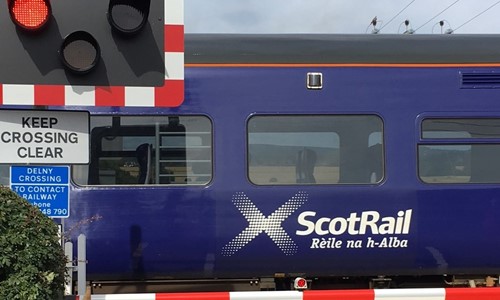Background
The Far North Line Review Group was established by Fergus Ewing MSP, Cabinet Secretary for Rural Economy in December 2016 with a remit to identify potential opportunities to improve connectivity, operational performance and journey time on the line.
Membership included senior representatives from the railway industry (Transport Scotland, Network Rail, ScotRail) as well as relevant stakeholders (HITRANS, Highland Council, HIE, Caithness Transport Forum and Friends of the Far North Line).
Over the past three years, the team has worked together to improve the Far North rail line.
Achievements to date
Safety and Improved Journey Time
- Implemented level crossing upgrades by installing an automatic barrier at Delny prior to closing the crossing by 2024.
- Upgraded two level crossings to full barriers.
- Upgraded open level crossing operations at Brora, Lairg and Rovie to deliver improved line speed and reduce end to end journey times.
- A programme of improved animal fencing and removed lineside vegetation to help safeguard livestock and deer.
- Created six new full-time posts in Helmsdale to address fencing and vegetation issues along the line.
- Increased the line speed near Chapelton Farm to 75mph.
Customer service improvements
- Implemented enhancements at Invergordon station including real time information at the port and wayfinding signage to assist local travellers and cruise ship visitors seeking onward travel.
- Rolled out solar powered Customer Information Screens at key stations.
Timescale and Infrastructure Development
- Identified the need for a substantial change to the timetable structure to address the differing needs of the communities (and visitors) along the length of the rail corridor.
- Developed proposals to address future demand and economic sustainability, including more regular services to meet growing numbers of commuters between Tain and Inverness. Also, providing better timed services both for intermediate and end-to-end journeys and to improve freight access on the line.
- Undertook a technical review and strategic analysis to understand the extent of improvements required to the track and signalling to support the proposed new enhanced service specification.
- Commissioned Network Rail to develop infrastructure proposals to deliver the proposed service specification.
Work in development
Signalling
Understanding the operation of the unique signalling system, Radio Electronic Token Block (RETB), operating in the Far North route led to the identification of several enhancement opportunities to improve operations on the route. These include:
- the introduction of Enhanced Token Transfer and Automated Train Describer integration. These improvements will streamline the exchange of safety-critical data by operational staff to the benefit of passengers and freight customers.
- Enhanced Token Transfer will better use the RETB system to reduce the “on air” radio time for token transfers which will greatly reduce the demand on the radio network, allowing it to be utilised in other ways, and reduce signaller and driver workload, whilst providing timetable resilience benefits. The proposal could have wider application through its use on the West Highland Line.
Request to Stop
- The Press ‘n’ Ride concept is one that has been promoted to improve performance and reliability of trains at “request-only” stops.
- This would see the installation of an automated request system at each station whereby the driver would be aware of any waiting passenger/s in advance, via an alert to the conductor generated by the communications system.
- If there was no requirement to stop, this would allow the driver to maintain line speed and help improve reliability in the first instance and eventually reduce journey times.
Identified Opportunities
A range of opportunities has been identified as a consequence of the workings of the Review Team and these include:
Freight
- It is positive to note that the train carrying pipes from Hartlepool to Georgemas Junction for the off-shore oil industry has restarted.
- Hitrans has been leading on various discussions including the potential to restart timber movement by rail and these discussions are ongoing.
Tourism
- Transport Scotland will work with the rail industry and stakeholders, including the North Highland Initiative, to explore a brand for the Far North Line.
- A detailed tourism pilot proposition is also under consideration with the aim of attracting more visitors on the line.
- There is clear potential to exploit the fact that the railway accesses parts of Sutherland and Caithness that are beyond the reach of the North Coast 500.
Transport Scotland intends to maintain the momentum stimulated by the Review Team through a single point of contact responsible for ensuring the consideration and, if appropriate, development and delivery of proposals with partners.
Next Steps
The Far North Line Review process has been successful. It has already identified and driven delivery of direct and ancillary benefits along the route, including new, sustainable employment in Helmsdale.
It has also set a programme of potential further improvements on the corridor, the development of which has now commenced:
- RETB Enhancements
- Request to Stop
- Automated Train Describer
- Enhanced Token Transfer
- Linespeed Improvements
- Lentran Loop Development
- Further RETB Enhancements
- Collapsing tokens
- Loop clear aids/automated loop clear
- Automated inter cabinet fringing
- Enhancements to user worked level crossings
Transport Scotland has approved further development work for the undernoted which would be considered as part of the wider ‘Pipeline Programme’. This includes developing a Strategic Business Case for improvements in services on the Far North Line.
Once this work concludes, investment recommendations will be presented to Transport Scotland who will assess the deliverability and affordability of the detailed options for potential implementation during Control Periods 6 and 7. A dedicated Transport Scotland project sponsor has been appointed to progress project development with Network Rail and ScotRail.
